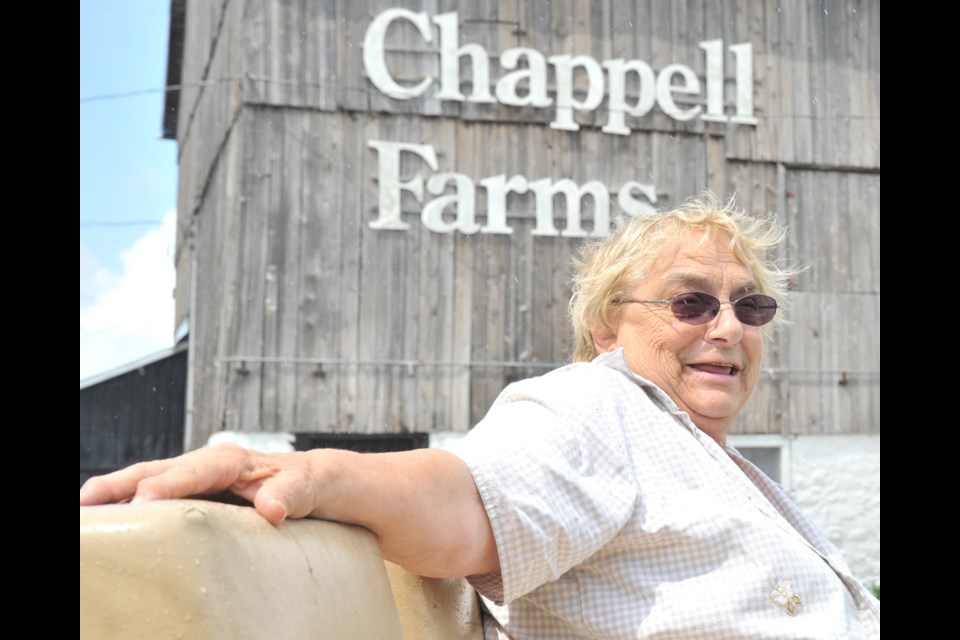Where does our food come from?
And why is that important?
Generations of families from Simcoe County, and many from much further afield, have asked those questions and found first-hand answers thanks to the efforts of the long-time family-run operators of Chappell Farms.
Pauline Chappell, a seventh-generation farmer at the family’s spread on Highway 93 just north of Barrie, has been giving families over the last 40 or so years an insight into why the work of farmers is so vital and why it’s important to know how our food gets to our tables every day.
Her family has been working the land at the same location since 1834, just a hop-skip-and-a-spit from the Drury family (Click here to read that story), who put down roots back in 1819.
“Few farms have been maintained by the same family for that long. So we’ve been next-door neighbours for 185 years,” Chappell says from her comfortable farmhouse kitchen, while taking a break from the August heat.
The Chappells offer up a farming experience for the uninitiated pretty much year-round.
This time of year it’s on-site grown corn, although in the fall it could be pumpkins or, closer to Halloween, a scary set up for youngsters and their (equally) spooked parents.
In the spring there is an Easter theme.
“We have an incubator set up where eggs are hatching so children can actually see a chicken come out of an egg shell and see it walk around fairly quickly,” Chappell says. “It’s intriguing to them.”
And throughout the year, the parents could be learning as much, if not more, than their children about food sourcing and love of the environment, she adds.
“Because their food connections are at a grocery store, city people don’t necessarily think about where it comes from or the stages it has to pass through to get to them,” Chappell says. “They don’t even realize that it’s seasonal or the implications involved with working with seasons.
“A city child really has no way to learn that because food comes in a box from a store; they don’t connect with it and where it comes from for them.”
Chappell says many of the visitors are multi-generational - many return year after year - and make a point of getting the word out.
“It’s amazing to watch (children and adults) learn about the animals and about growing things and harvesting things,” she says, sprouting a smile. “Some parents can’t tell their kids anything about it; they haven’t had the opportunity (to know better).
“Now people are becoming more aware about the cycle of nature and the problems when it’s not handled well: environmental issues and all that.”
It can also be about kids bringing awareness about farming, sustainability issues and climate awareness to the (dinner) table, Chappell adds.
“Sometimes they’re learning about that together when they come here, and that’s a good thing,” she says.
“They pick a pumpkin or something we have at the market freshly picked or they see the bees in action,” she adds. “So they see the effect of planting and growing and associate it with eating, as opposed to going to the store and buying something in a box.
“They associate it with fun and pleasure and wholesomeness.”
People might not have the understanding or a connection to the land, Chappell says, adding they haven’t touched it or seen it, perhaps not grabbing a chunk of earth in their bare hands.
“Their parents can’t tell them anything about it,” she says of youngsters. “They haven’t had the opportunity. It’s like a car; you don’t think about how it’s assembled or how it’s made. You drive it,” she says.
“I think it’s a connection with the reality of life. Without that, nothing is fed,” adding that a walk through the farm’s areas - involving animals, crops and insects’ working progress - can be an eye opener for people of all ages.
“I think it feeds their personality,” Chappell says of sharing the life and love of farming with ‘urban’ folk who might not have a personal handle on it.
“It’s more than just nourishment; it’s something they can learn and live by. In our generation, people weren’t aware of what was happening, let alone the effects of it,” she says.
